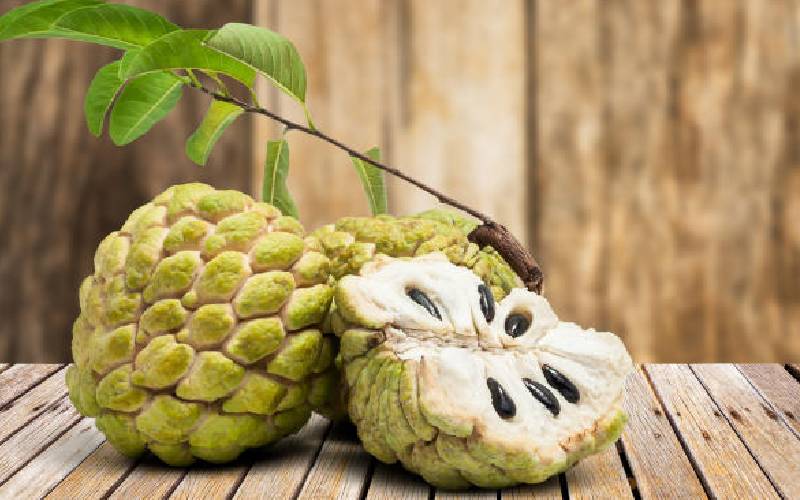
Custard apple is a subtropical deciduous woody shrub that has branches that spread irregularly and can reach eight meters high under favourable conditions.
The fruit is lumpy-skinned with a soft sweet pulp that is rich in carbohydrates, vitamins A and C. The fruit can be consumed when ripe or used in ice creams or desserts.
Compared to soursop, custard apple is more common in Kenya and is locally known as matomoko.
Custard varieties that perform well in Kenya include Hybrid, Washington, Balanagar and Red Sitaphal.
Silas Munyoki, a custard apple farmer from Machakos County, shares tips on how to get the best out of the crop.
Ecological requirements
The crop thrives in moderate and well-distributed rainfall. It can be grown under irrigation in dry areas. Favourable temperatures for the plant range from 15 degrees to 30 degrees centigrade. “Custard apple is sensitive to extremely low temperatures. A hot dry climate enhances flowering and fruit set,” says Munyoki. The crop thrives in well-drained sandy-loam soils with a pH range of 5.0 to 8.0.
Planting
According to Munyoki, custard plants require a spacing of four metres by four metres or six metres by six metres. Planting holes should have a diameter of 60cm by 60cm and 60cm deep. The topsoil should be mixed with well-decomposed manure to improve soil fertility and aeration. This means that an acre can occupy between 150 to 300 trees depending on the spacing. The plant starts flowering in the third or fourth year, depending on environmental conditions and occurs once a year. “They can be propagated from seed collected from selected mother plants or through cuttings, layering, grafting or budding. Farmers should plant seedlings at the beginning of the rainy season for proper establishment of plants,” advises Munyoki.
Manure and fertiliser requirements
It is uncommon to apply manures and fertilisers to custard apples, but it shows a good response to fertilisation in terms of vigour, yield and quality. Fertiliser application can extend longevity and check the decline of trees.
Weeding
Custard orchards should be weed-free. Planting cover crops and mulching is recommended to minimise the growth of weeds. Apply biodegradable mulch to contain soil moisture.
Pests and diseases
Stay informed. Subscribe to our newsletter
Farmers should look out for pests such as trunk and fruit borer, spider mites, aphids, thrips and diseases like leaf-spot, Blackstone, anthracnose and root rot.
Harvesting
Custard trees start bearing three to four years after planting. Grafted varieties are capable of producing yields two years after planting. The fruit is green when unripe and turns yellow or orange when ripe. The yield of the crop depends on soil type, variety, water source, and other orchard management practices.
Marketing
The demand for custard apples in the local and export market is yet to be met. Europe provides the largest market for Kenyan custard apple fruits.
 The Standard Group Plc is a
multi-media organization with investments in media platforms spanning newspaper
print operations, television, radio broadcasting, digital and online services. The
Standard Group is recognized as a leading multi-media house in Kenya with a key
influence in matters of national and international interest.
The Standard Group Plc is a
multi-media organization with investments in media platforms spanning newspaper
print operations, television, radio broadcasting, digital and online services. The
Standard Group is recognized as a leading multi-media house in Kenya with a key
influence in matters of national and international interest.
 The Standard Group Plc is a
multi-media organization with investments in media platforms spanning newspaper
print operations, television, radio broadcasting, digital and online services. The
Standard Group is recognized as a leading multi-media house in Kenya with a key
influence in matters of national and international interest.
The Standard Group Plc is a
multi-media organization with investments in media platforms spanning newspaper
print operations, television, radio broadcasting, digital and online services. The
Standard Group is recognized as a leading multi-media house in Kenya with a key
influence in matters of national and international interest.





